I should have listened to Sylvia.
I knew the beautiful, hot-pink queen’s wreath, AKA corona de reina, (Antigonon leptopus) vine was invasive when I planted it. But it’s so pretty!
And then last year, a friend had told Sylvia — who told me — that he had watched caterpillars eat the leaves of the queen’s wreath. None of the caterpillars lived. “But it’s so pretty,” I’d proclaimed.
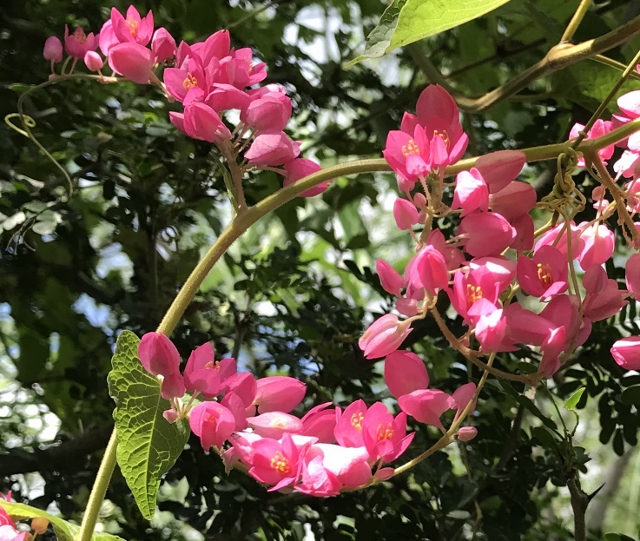
Here was my theory when I’d planted the vine: I’d plant it next to our fence where it would scramble over into the neighbor’s field of the more invasive giant reed (Arundo donax), strangle the reeds, which would then quit cropping up in my yard and creating more work for me, and thereby save the resaca from the water-guzzling reeds.
I was thinking the environment would take care of itself; I’d have the enjoyment of beautiful pink flowers for a couple of years and when the vine got out of hand, I’d dig it out. You know, one of those illusive win-win-win situations that never pan out.
Alas, that “dig it out” time came last week when my husband wanted the vine out of his chinaberry tree.
Yes, yes. I know — the chinaberry tree (Melia azedarach) also is on the Texas invasive list, but my husband, who doesn’t ask for much, grew up in middle Texas, and wanted the nostalgic memory — back in the day, the dried fruit of the chinaberry tree was excellent sling-shot ammunition.
And if the chinaberry tree got out of hand, we’d just cut it down. Simple. Besides, it’s so pretty! In the spring, it has lovely, dusky-lavender flowers with dark purple centers hidden in the dark green canopy. When you find the flower clumps, they’re really pretty in a mystic, “Delta Dawn” sort of way.
So, logical theory aside, here’s what really happened in that corner of our yard:
The queen’s wreath wouldn’t befriend the fence. Instead, it wended its way through the tangle of slow-growing Texas ebony branches, wrapped itself around the giant reed stalks that had escaped into our yard and were growing at the base of the ebony tree, and then jumped to the top of the chinaberry tree (that I’d planted too close to the ebony).
Unbeknownst to me, my husband had spent last year periodically pruning the three-year-old chinaberry tree to the shape-perfection that he wanted. So I agreed, it was time to remove the queen’s wreath.
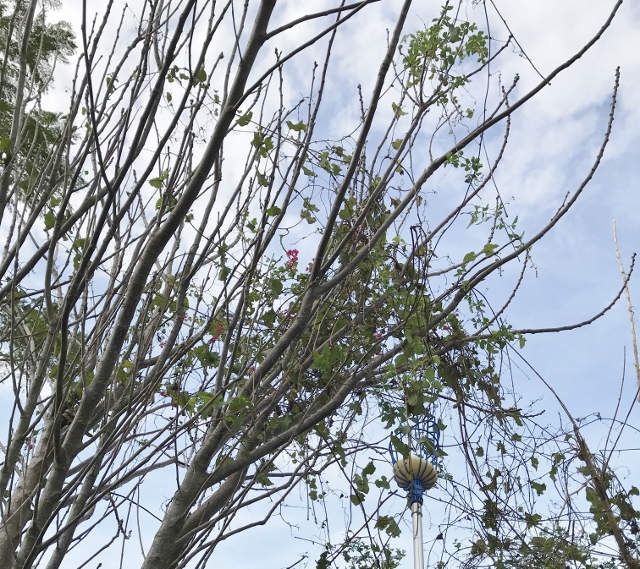
The chinaberry tree is three times the height of the five-year-old Texas ebony, which is about six feet. The chinaberry tree had dropped its leaves for winter so it was an ideal time to tackle the chore. I tugged the vines from the bare branches using a citrus-picker — a metal basket with hooks on one side attached to an extension pole.
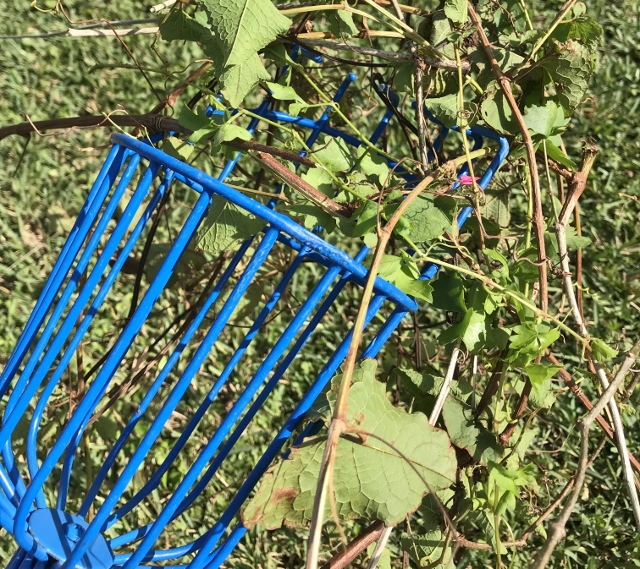
Dragging the vines out of the wickedly thorny, crooked mass of ebony branches took quite a while longer and used massive amounts of upper arm strength.
To alleviate any future problems with the beautiful but treacherous vine, I dug up the roots. It’s amazing what tender little roots can do when unsupervised and hidden in the soil for a length of time.
I sliced the sharpshooter shovel into the ground where I had planted the vine, continually expanding my circle of dig — which wasn’t easy since the vine stem was now sheltered by low hanging branches of the ebony — which is probably planted too close to the fence.
Down on my hands and knees, I eventually dug out an amazing clump of roots, nodes, stems and huge nut-like pods nearly the size of my fist (think pecans on steroids) described as tubers in the Richardson, A., King, K., 2011. Plants of Deep South Texas: A Field Guide to the Woody and Flowering Species. Texas A&M University press, College Station, page 354.
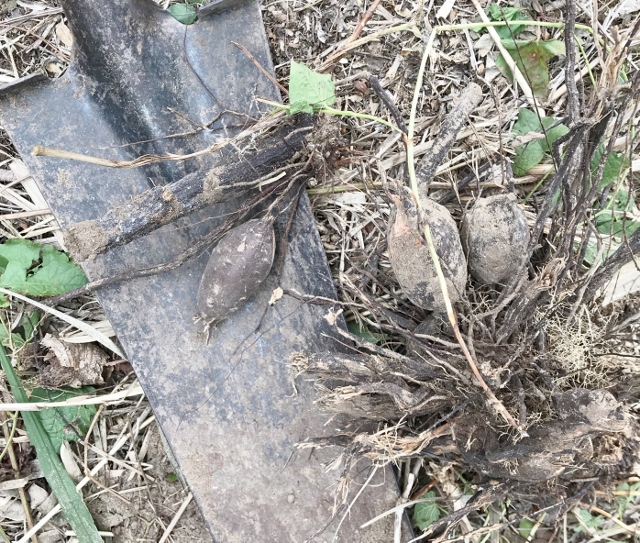
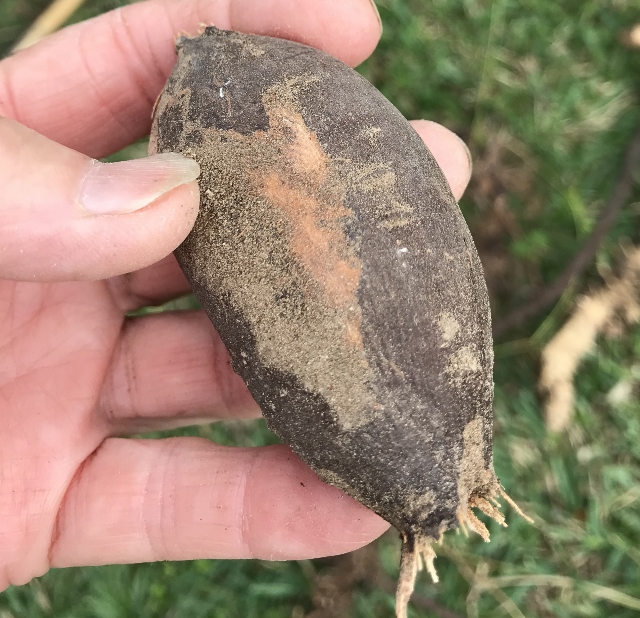
I hadn’t quite learned my lesson about not messing with invasivies, and was thinking to plant a blue sky vine, although Sylvia, my friend and fellow Texas Master Naturalist from our sister chapter, again cautioned me by saying, “nothing has ever been seen nectaring on it.” Still, it’s SO PRETTY!
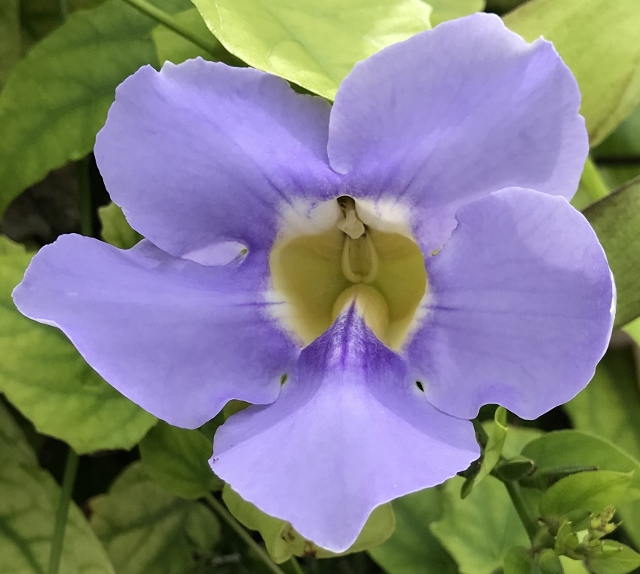
Blue sky vine, also called bengal trumpet (Thunbergia grandiflora), is native to the sub-tropical Indian continent of Southern China. I Googled it. I read a lot about the plant and also looked for one of my favorite websites, www.davesgarden.com — if you scroll down, you’ll find a comments section with negative, positive and neutral comments.
One negative entry caught my eye: “. . . massive tuber network may get underneath your house and start lifting it up . . . .” The comment was from Taiwan — in zone 11. We’re zone 10 — I did the math. I will not be growing this beautiful but reckless vine in our yard!
The morals to this story:
- Don’t plant trees too close together
- Find out what a root system might do — prior to planting something
- Do your research before you plant
- Don’t create your own habitat logic
- Be prepared to correct your mistakes
- Consider the labor involved with correcting your mistakes
- Don’t mess with invasive species
Just as a matter of interest, while digging out the roots of the queen’s wreath vine, I also dug out a partial rhizome of the giant reed that I’d previously sliced off and poisoned from under the ebony (an on-going task). The rhizome was adjacent to the queen’s wreath tubers. I was horrified when I figured out what it was.
In the photo below, on the left is a two-foot portion of queen’s wreath roots; on the right, a three-foot portion of an underground giant cane rhizome.

Read up on the invasive species mentioned in this blog post at the following links.
Corona de reina https://www.texasinvasives.org/plant_database/detail.php?symbol=ANLE4
Giant reed https://www.texasinvasives.org/plant_database/detail.php?symbol=ARDO4
Chinaberry tree https://www.texasinvasives.org/plant_database/detail.php?symbol=MEAZ
Google bengal trumpet Thunbergia grandiflora to read about the beautiful blue sky vine (not listed in the Texas Invasives website but can take over small villages).

Leave a Reply